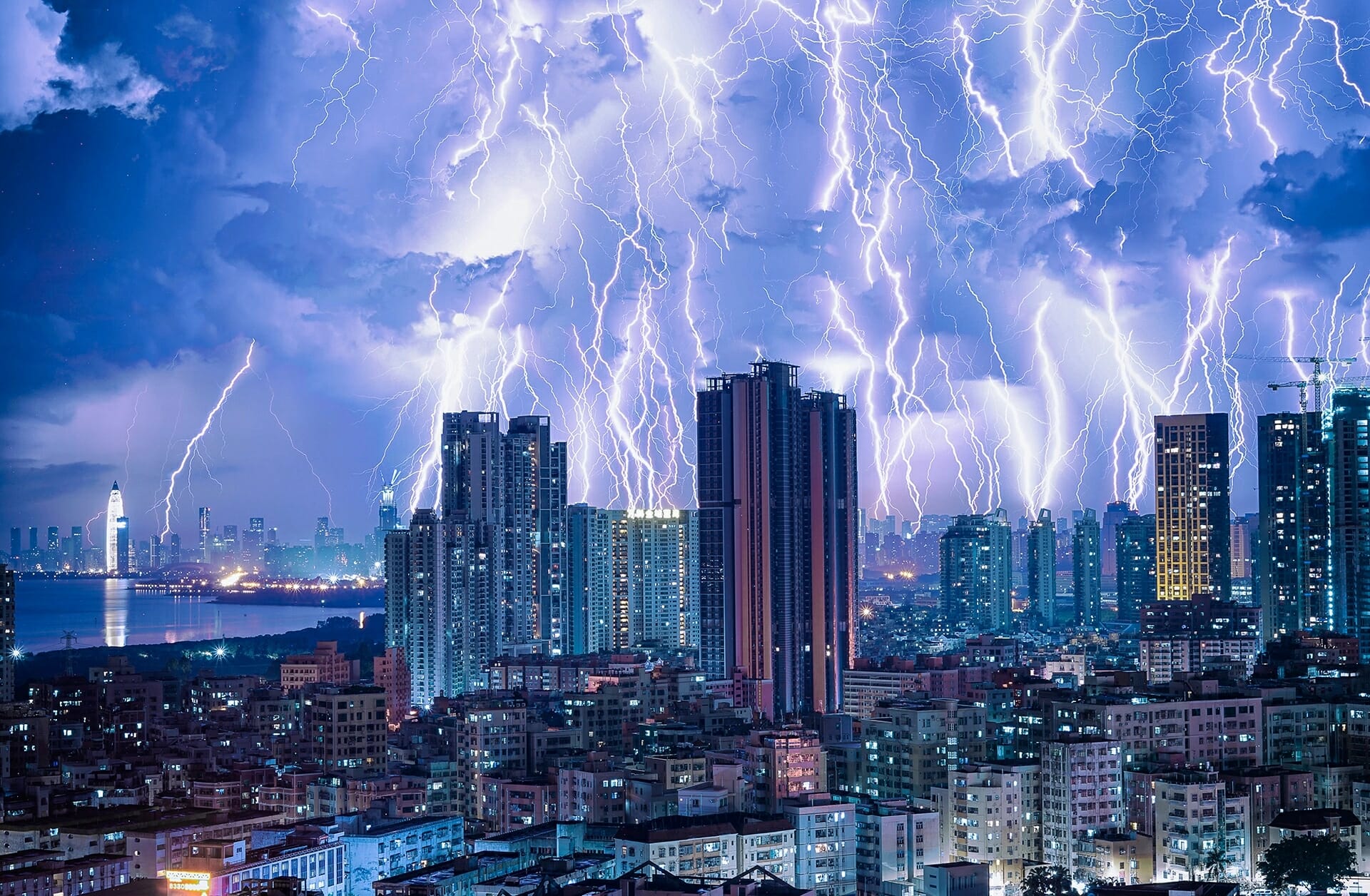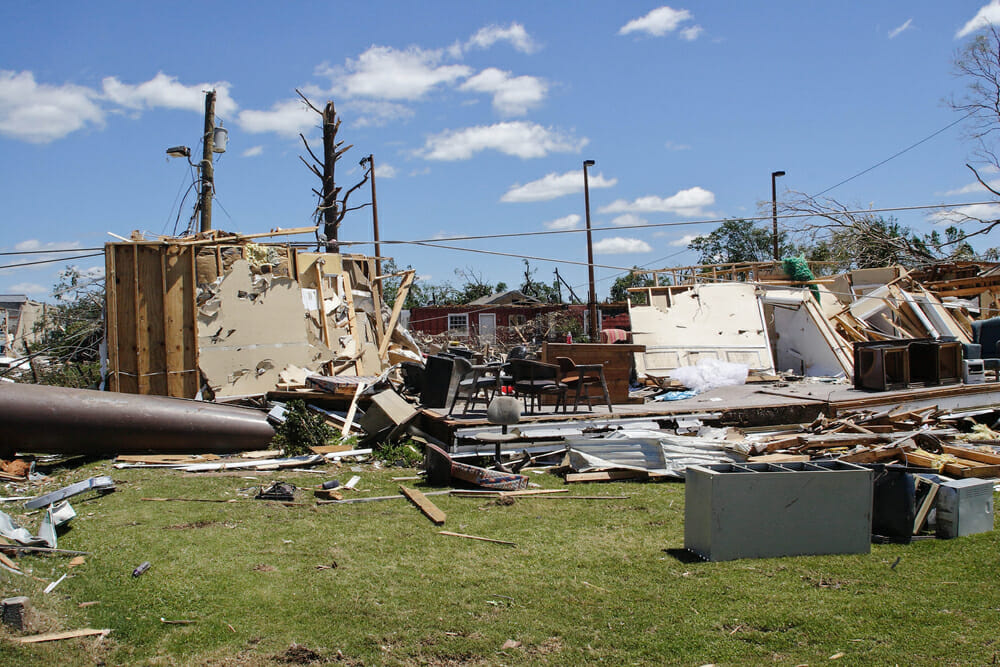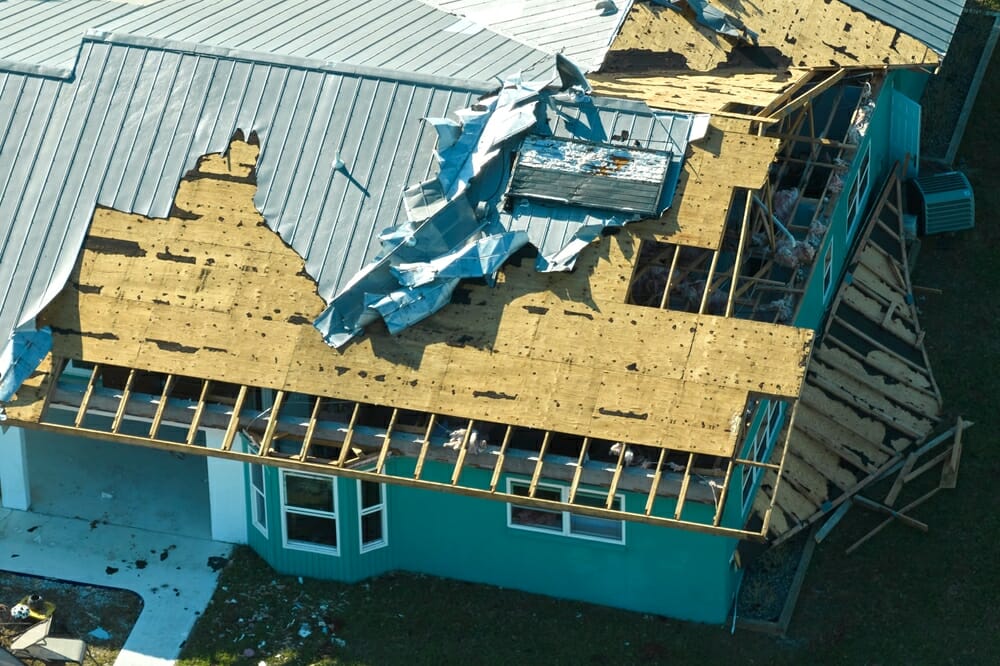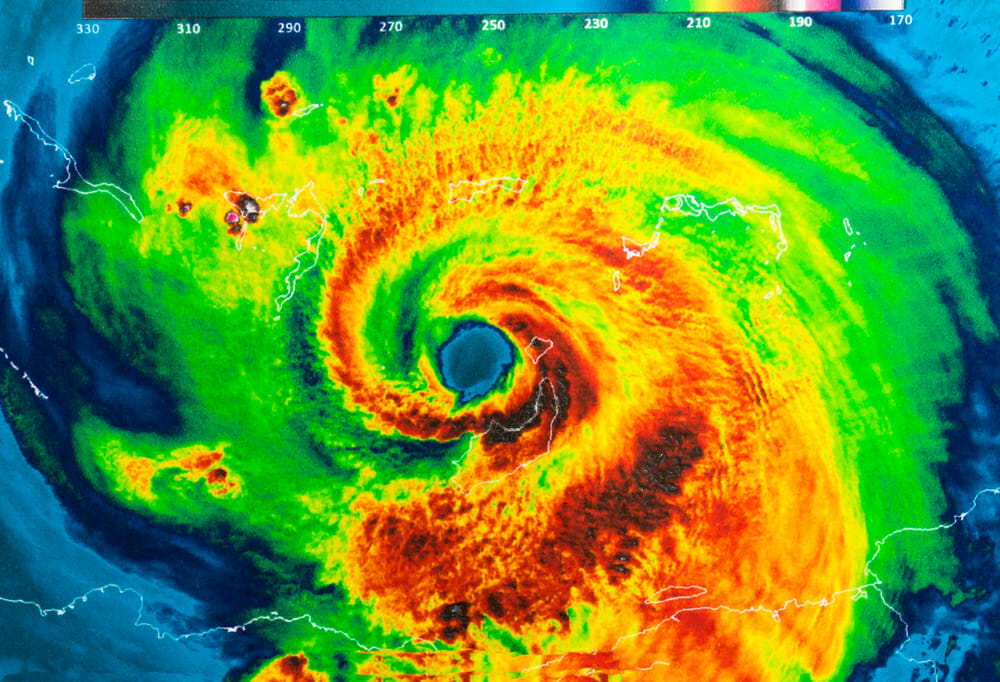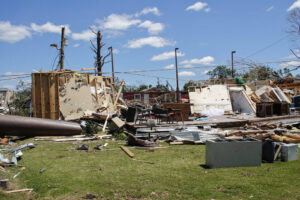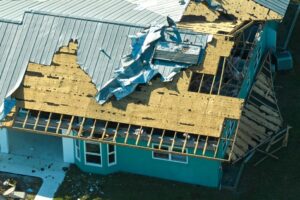Introduction
Does homeowners insurance cover lightning strike damage? Yes, it typically does. Homeowners insurance generally includes coverage for direct damage caused by lightning strikes, such as fires, electrical surges, and structural impacts. However, understanding the nuances of what’s covered can help ensure you are fully prepared ahead of any incident.
Lightning is both fascinating and fearsome. According to National Geographic, a single bolt of lightning can heat the surrounding air to temperatures five times hotter than those on the surface of the sun. With around 100 lightning bolts striking the Earth’s surface every second, the potential for damage is significant. Recognizing this, the Insurance Information Institute reported that in one year alone, lightning claims in the U.S. totaled $909 million, affecting nearly 78,000 policyholders.
For property owners and managers of commercial buildings, multifamily complexes, and other organizations, the frequency and intensity of lightning strikes present a substantial risk. Whether it’s a direct strike that chars structural components or an indirect surge that fries circuitry, the financial implications can be staggering.

In the sections that follow, we will explore the specifics of insurance coverage for lightning strikes, types of damages you might encounter, and how to effectively file a claim to address this volatile force of nature.
Understanding Your Coverage
When it comes to understanding what your property insurance policy covers, it’s crucial to start with the basics of home insurance. Home insurance typically includes coverage for a variety of perils that could damage your home and belongings. Among these, does homeowners insurance cover lightning strike damage? Yes, it generally does. Here’s a breakdown of what’s typically covered:
Home Insurance Basics
Home insurance policies are designed to protect your home and personal property against specific perils listed in the policy. These usually include fire, theft, and yes, lightning strikes. This coverage extends to both the physical structure of your home and the belongings inside it.
Covered Perils
Specifically for lightning, the coverage can include damage from:
– Fire caused by a lightning strike.
– Electrical surges that result from a lightning strike, potentially damaging the wiring and appliances in your home.
Extended Coverage
Some policies offer extended coverage options that go beyond standard perils. This can be beneficial if you live in an area prone to severe thunderstorms and lightning. Extended coverage might include higher limits or additional perils related to storm damage.
Comprehensive Coverage
Comprehensive coverage offers a broader level of protection, covering more than just the basic perils. While it includes lightning, this type of coverage typically covers damages from almost all sources unless specifically excluded. This is often considered for high-value homes or areas with frequent volatile weather.
Equipment Breakdown Coverage
In the context of lightning strikes, one important aspect to consider is equipment breakdown coverage. This is an add-on or a separate policy that covers the cost of repairing or replacing electrical appliances and systems damaged by artificially generated electrical currents, including those from lightning. It’s a valuable addition if you have high-end electronics or other sensitive equipment at home.
Understanding these coverage options helps you assess whether your current home insurance policy sufficiently protects you against the financial impact of lightning strikes. By knowing what your policy includes and where it might fall short, you can make informed decisions about potential upgrades or additional coverage. This is especially important given the unpredictable nature of lightning and the significant damage it can cause.
In the next section, we’ll delve into the types of lightning damage and how insurance companies typically respond to claims, ensuring you have all the information needed to navigate this aspect of your homeowners policy effectively.
Proving Lightning Damage
Proving lightning damage to your property can be crucial in ensuring your insurance claim is accepted and adequately compensated. Here’s how to effectively assess and document the damage.
Assessment Tips
Start by conducting a thorough inspection of your property immediately after the storm. It’s important to document all damages before any repairs are made. Look for obvious signs of lightning impact such as burn marks or structural damages.
Evidence Collection
Photographs and Videos: Capture clear images and videos of all damages. Focus on areas where lightning directly struck or where damage from secondary effects like power surges is evident.
Gather Documentation: Collect any relevant documents such as reports from the fire department, weather reports indicating a lightning storm, and statements from witnesses if available.
Identifying Specific Damages
- Char Marks: These are often blackened areas found on electrical outlets, appliances, or where the lightning made contact with the house.
- Holes: Check for any punctures in the roof or walls, which can indicate a direct strike.
- External Damage: Look for damages to external structures like sheds, detached garages, and trees. These can also show signs of a lightning hit.
Role of an Adjuster
Once you have documented the damage, an insurance adjuster will visit your property to verify your claims. They will assess the physical evidence and may also consult with electrical engineers or other specialists to determine the extent and cause of the damage. The adjuster plays a critical role in determining how much the insurance company will cover.
Documentation is Key: Ensure all your collected evidence is organized and ready to present to the adjuster. This includes photographs, videos, and any professional assessments you have acquired.
By meticulously documenting the damage and understanding the role of the adjuster, you can effectively prove that your property sustained damage due to a lightning strike. This detailed approach helps ensure that your insurance claim is processed smoothly and reflects the true extent of the damage.
In the following section, we will explore the different types of lightning damage and how insurance companies typically respond to these scenarios. This knowledge will further equip you to handle the complexities of does homeowners insurance cover lightning strike damage and secure the necessary compensation.
Types of Lightning Damage and Insurance Response
Lightning is a powerful natural phenomenon that can cause a wide range of damages to your property. Understanding the types of lightning damage and how your insurance policy responds is crucial in preparing for and recovering from such events. Here, we break down the common types of lightning damage and the typical insurance responses.
Direct Strike
A direct strike occurs when lightning hits your home or structures directly. This can lead to severe structural damage, fires, and even explosions. Homeowners insurance generally covers direct strikes, providing funds for repairs to the dwelling and other structures on your property.
Near Miss
Damage from a near miss happens when lightning strikes close to your home but does not hit it directly. This can still cause electrical problems and minor physical damage. Proving this type of damage to your insurance provider can be challenging, as the effects are often less visible.
Ground Surge
Ground surges occur when a lightning strike impacts the ground near your home, causing an increase in electrical current that can flow into your property. This surge can damage electrical systems and appliances. Claims for ground surges require evidence of the surge, such as fried electronics or affected appliances.
Tree Damage
If lightning strikes a tree or large branches, the resulting fall can damage your home, vehicles, or other structures. Insurance typically covers this type of damage under the policy’s provision for falling objects and debris.
Electrical Surge
An electrical surge can happen during a lightning storm, even without a direct strike. This surge can overload and damage electronics and appliances. While homeowners insurance covers lightning damage, it’s wise to add equipment breakdown coverage to specifically address surge damage, which offers broader protection for high-value electronics.
Personal Property Damage
Items inside your home, such as electronics, furniture, and personal belongings, can be damaged by fire, smoke, or electrical surges resulting from lightning. Your homeowners insurance policy covers personal property damage, ensuring you can repair or replace items affected by the strike.
Other Structures Coverage
This part of your homeowners insurance extends to structures on your property that are not attached to your main home, like garages, sheds, and fences. If these structures are damaged by lightning or resulting events like tree falls or fires, they are typically covered.
Additional Living Expenses
If a lightning strike makes your home uninhabitable, your insurance policy may cover additional living expenses. This coverage helps with costs related to temporary housing and other daily expenses while your home is being repaired.
Understanding these types of damages and the corresponding insurance responses helps you prepare better for potential claims. Always review your insurance policy details to know exactly what is covered and consider additional coverage options to fill any gaps, ensuring comprehensive protection against all types of lightning damage.
Filing a Lightning Strike Insurance Claim
When lightning strikes, it can be a shocking and damaging event for any homeowner. Understanding how to file an insurance claim effectively can help you navigate this stressful time more smoothly. Below, we’ll explore the key steps and considerations involved in the claim filing process, specifically focusing on how your deductible affects the claim, the settlement process, and how companies like American Family Insurance handle these incidents.
Claim Filing Process
1. Document the Damage: As soon as it is safe, document all damages caused by the lightning strike. Take clear photographs and make detailed notes about the extent of the damage. This will be crucial for your insurance claim.
2. Contact Your Insurance Company: Report the incident to your insurance provider as soon as possible. You can file your claim online, through an app like MyAmFam, or by calling customer service directly. For American Family Insurance, the number is 1-800-MYAMFAM (1-800-692-6326).
3. Claim Review by Adjuster: After you file your claim, an insurance adjuster will be assigned to your case. They will inspect the damage and assess the claim to determine the amount of loss covered by your policy.
Deductible Considerations
Before any settlement can be processed, you will need to consider your deductible. This is the amount you agreed to pay out-of-pocket when you signed your insurance policy. If the cost of repairs is greater than your deductible, filing a claim is worthwhile. However, if the damage cost is close to or less than your deductible, it may be more economical to handle the repairs independently.
Settlement Process
1. Initial Payment: Once your claim is approved, you will typically receive an initial payment. This is part of your total settlement and helps you start the repair process.
2. Completion of Repairs: After repairs are completed, you may receive a second payment if the initial payout didn’t cover all the expenses.
3. Full Settlement: The total amount you receive will be the cost of the repairs minus your deductible.
American Family Insurance Example
With American Family Insurance, the process is streamlined to support policyholders effectively. They offer multiple filing options and a detailed tracking system through their MyAmFam app, allowing you to see the status of your claim in real-time.
Claim Filing Options
- Online: Quick and easy, suitable for tech-savvy policyholders.
- Phone: Direct communication, helpful for those needing additional support.
- App: Convenient for on-the-go updates and submissions.
Adjuster Assessment
The adjuster plays a critical role in the claims process. They evaluate the evidence of damage, estimate repair costs, and determine the payout amount based on your policy details. It’s important to provide them with all necessary documentation and evidence to support your claim effectively.
Payment Increments
Understanding how your insurance company handles payments is crucial. In most cases, the settlement comes in two parts:
– First Increment: An upfront payment to start repairs.
– Second Increment: A final payment once all repairs are verified and completed.
Navigating a lightning strike insurance claim involves several steps from documenting damage to receiving payment. Knowing these steps and preparing in advance can make the process less daunting. Always ensure you understand the details of your insurance policy and keep all records of communication and transactions related to your claim. This organized approach will help you achieve a fair and timely resolution to your lightning strike claim.
Preventing Lightning Damage
Preventing lightning damage is crucial for safeguarding your home and belongings during thunderstorms. Here are practical steps you can take:
Unplugging Electronics
- Why: Lightning can cause power surges that damage electronic devices.
- How: Before a storm hits, unplug televisions, computers, and other sensitive electronics to protect them from sudden electrical spikes.
Fire Extinguisher
- Why: Lightning strikes can ignite fires quickly.
- How: Keep at least one fire extinguisher accessible in your home. Ensure everyone knows how to use it.
Smoke Detector
- Why: Early detection of fire gives you time to react and minimize damage.
- How: Test your smoke detectors monthly and replace batteries annually. This simple step can be life-saving.
Lightning Protection System
- Why: To provide a direct path for lightning to follow, minimizing damage.
- How: Install a system designed to safely ground lightning strikes. This system includes air terminals, bonding conductors, and ground electrodes.
Surge Protector Devices
- Why: To protect your home electronics and appliances from voltage spikes.
- How: Use surge protectors for all major appliances. Look for products that meet UL standards for the best protection.
By implementing these measures, you can significantly reduce the risk of damage from lightning strikes. Each step helps to protect different aspects of your home and can be a crucial part of your overall strategy to keep your property and family safe during storms.
Next Steps: As the storm approaches, ensure all preparations are in place and stay informed about the weather conditions. Safety is the priority.
Safety During Thunderstorms
When a thunderstorm rolls in, ensuring your safety and the safety of those around you becomes paramount. Here are essential tips on staying safe indoors, avoiding dangerous locations, and conducting a post-storm survey.
Indoor Safety
Stay Indoors: The safest place during a thunderstorm is inside a sturdy building. Avoid small sheds or standalone structures.
Keep Away from Windows: Windows can shatter during a storm due to strong winds or hail. Stay in interior rooms away from windows to avoid injury.
Avoid Electrical Equipment and Plumbing: Do not use wired electronic devices such as desktop computers or gaming consoles. Lightning can travel through electrical systems. Similarly, avoid activities like bathing or washing dishes, as plumbing can also conduct electricity from a lightning strike.
Avoiding Dangerous Locations
Do Not Shelter Under Trees: Trees are common lightning targets. If you are caught outside and cannot reach a safe building, avoid standing under trees or other tall isolated objects that can attract lightning.
Stay Off Elevated Areas: Hills, mountain ridges, and other elevated areas make you more susceptible to lightning strikes. Move to lower ground if you are outdoors during a storm.
Avoid Large Metal Objects: Do not touch or be near large metal objects like fences or poles, which can conduct electricity.
Post-Storm Survey
Check for Damage: Once the storm has passed, inspect your property for any signs of damage. This includes checking for fallen branches, damage to the roof, or signs of fire.
Smell for Gas: If you detect the odor of gas or hear a hissing noise, leave the area immediately and contact your gas company. Do not turn on lights or use anything that could ignite a spark.
Inspect Electrical Appliances: If you suspect any of your electrical systems have been affected, have a licensed electrician inspect them before turning the power back on to prevent further damage.
By following these guidelines, you can enhance your safety during a thunderstorm. Preparation and knowledge are key—does homeowners insurance cover lightning strike damage? Yes, but minimizing risk in the first place is always preferable. After ensuring everyone’s safety, document any damages to support any necessary insurance claims.
Conclusion
At Insurance Claim Recovery Support LLC, we understand how overwhelming and confusing navigating property insurance claims can be, especially when dealing with the aftermath of lightning strikes. That’s why we are dedicated to advocating for policyholders, ensuring that you receive the maximum settlement possible.
Advocacy for Policyholders
Our team works tirelessly on your behalf to navigate the complex insurance landscape. We believe that every policyholder deserves a fair chance at claiming what is rightfully theirs. Our expertise in policy interpretation and claim negotiation helps remove the burden from your shoulders, making the claims process as smooth and stress-free as possible.
Maximizing Settlements
Lightning damage can be severe and costly. We specialize in accurately assessing the extent of the damage and fighting for a settlement that truly covers the cost of repairs and replacements. Our goal is to ensure that you are not left out-of-pocket due to inadequate insurance assessments or settlements.
Texas Locations
With Texas being one of the states most prone to lightning and storm damage, our presence here is crucial. We have extensive experience dealing with local insurance companies and understand the specific challenges that Texans face when it comes to lightning and other storm-related damages.
Fire and Storm Damage Expertise
Our team is not only skilled in handling lightning damage claims but also has a deep understanding of related fire and storm damage. This comprehensive knowledge ensures that no matter how complex your situation, we can handle it with expertise and care.
In conclusion, navigating the aftermath of a lightning strike can be daunting. With Insurance Claim Recovery Support LLC by your side, you can face this challenge with confidence. Let us advocate for you and ensure that your property is restored and your financial interests are protected. For more details on how we can assist you, please visit our service page.
When lightning strikes, you’re not alone. We’re here to light the way to recovery.

